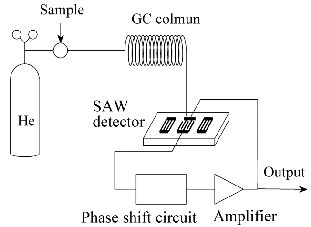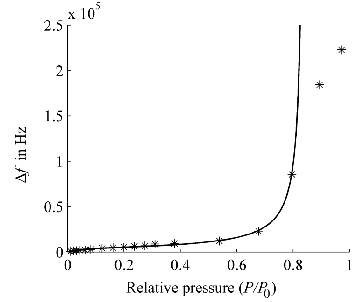Surface acoustic wave (SAW) sensors are one of the hot points in recent researches on gas sensing. The key unit of a SAW gas sensor is an oscillator consisting of a periphery circuit and an SAW detector. And the amount of absorbed gas can be known from the frequency shift of the oscillator. As well, the type of gas is determined by the sensing film, which is deposited on the detector surface, or a gas chromatography (GC) column, which is set in front of the detector.
The previous theoretical methods, such as Wohljent’s theory and Martin’s theory, were focused on SAW velocity changes caused by a known layer on the device surface. Researches were seldom performed on the relationship between the adsorption quantity and the gas concentration (or pressure).
In this research, a theoretical model is presented for the response mechanism of SAW gas sensors with gas adsorption on the detector surface. Wohljent’s method is adopted to describe the relationship between SAW sensor output (frequency or velocity shift) and the mass layer (the amount of absorbed gas) loaded on the surface of SAW detectors. Meanwhile, the Brunauer-Emmett-Teller (BET) formula and its improved form are introduced to analyze the adsorption behavior of a gas on the surface of a SAW device. The BET formula describes the relationship between gas adsorption amounts and gas pressures, which can be obtained from gas concentration by using the gas state equation. And then, the response mechanism of SAW gas sensors is obtained.
An experiment is performed by using a SAW-GC gas sensor to verify the theoretical model. The frequency shifts caused by different concentration of dimethyl methylphosphonate are measured and the parameters in the model are given by fitting the experimental data. It shows that the theoretical curve agrees well with the experimental results. The developed model and the discussions on the adsorption behavior of gas on the SAW detector surface will benefit attempts to achieve a SAW gas sensor with better performance.

Fig.1 Schematic of the SAW-GC analyzer used in the experiment (Image by LIU).
.

Fig. 2 The oscillation frequency shift Δf versus the relative pressure P/P0 at the detector temperature of 25 °C. Solid line: the calculated curve; stars: the measured data (Image by LIU).
Journal References:
LIU Jiansheng and LU Yanyan. Response Mechanism for Surface Acoustic Wave Gas Sensors Based on Surface-Adsorption. Sensors (vol. 14, pp. 6844-6853, April 2014). DOI: 10.3390/s140406844
Corresponding author:
LIU Jiansheng, Institute of Acoustics, Chinese Academy of Sciences, Beijing 100190, China
Email: liujs98@hotmail.com or liujiansheng@mail.ioa.ac.cn


